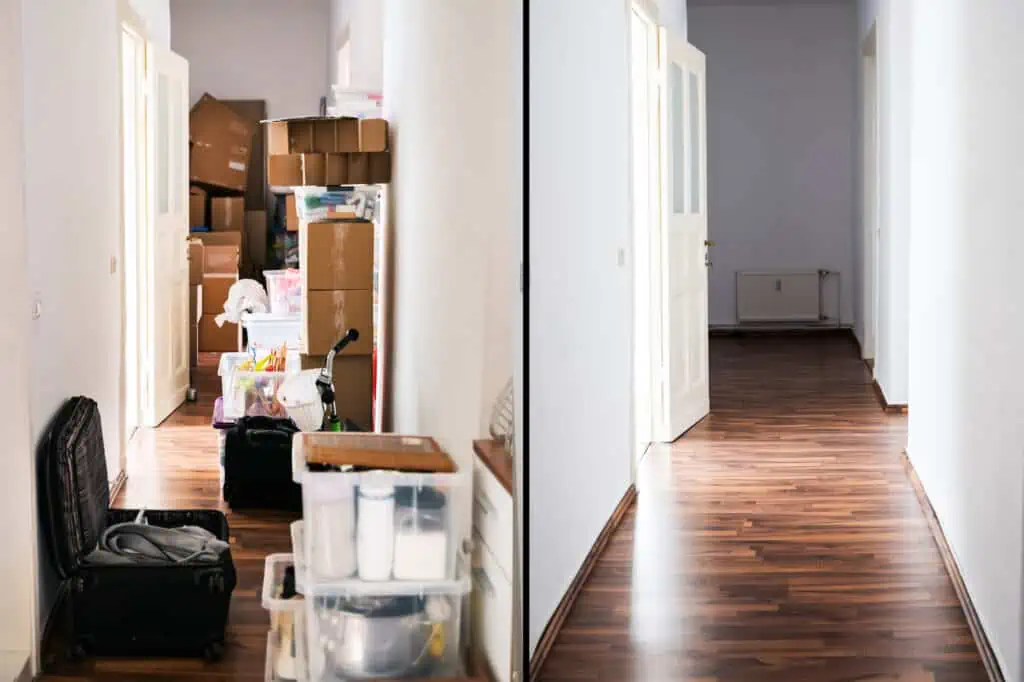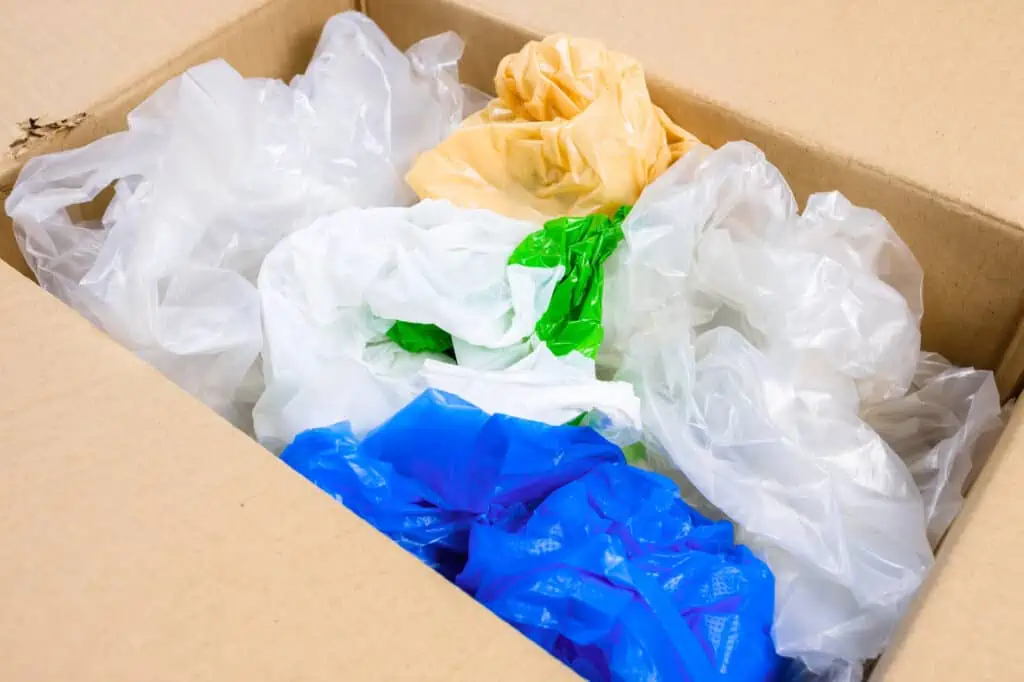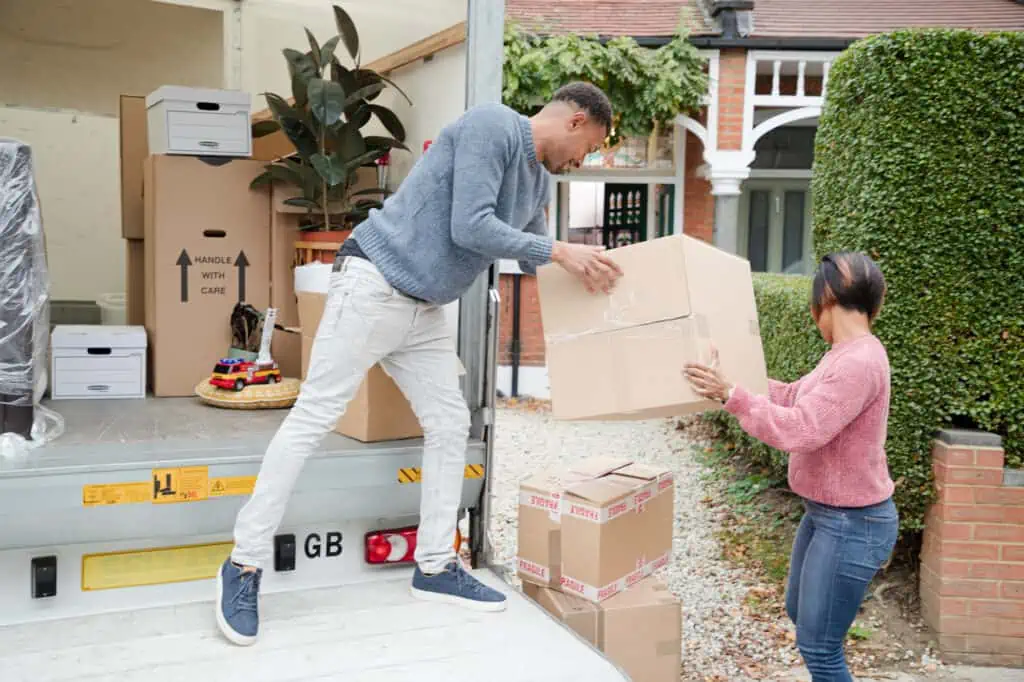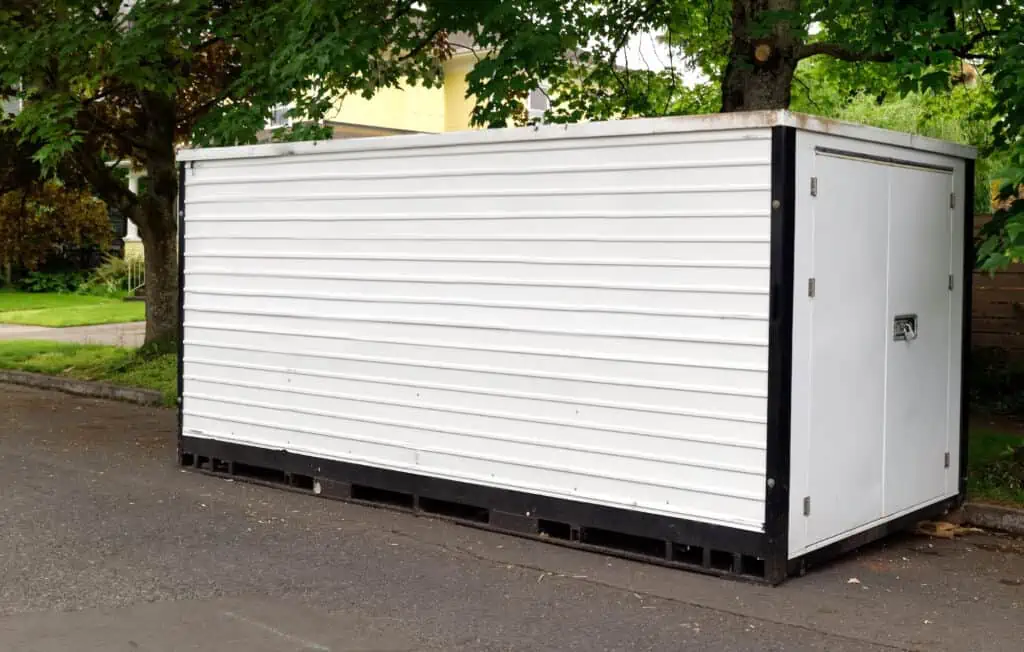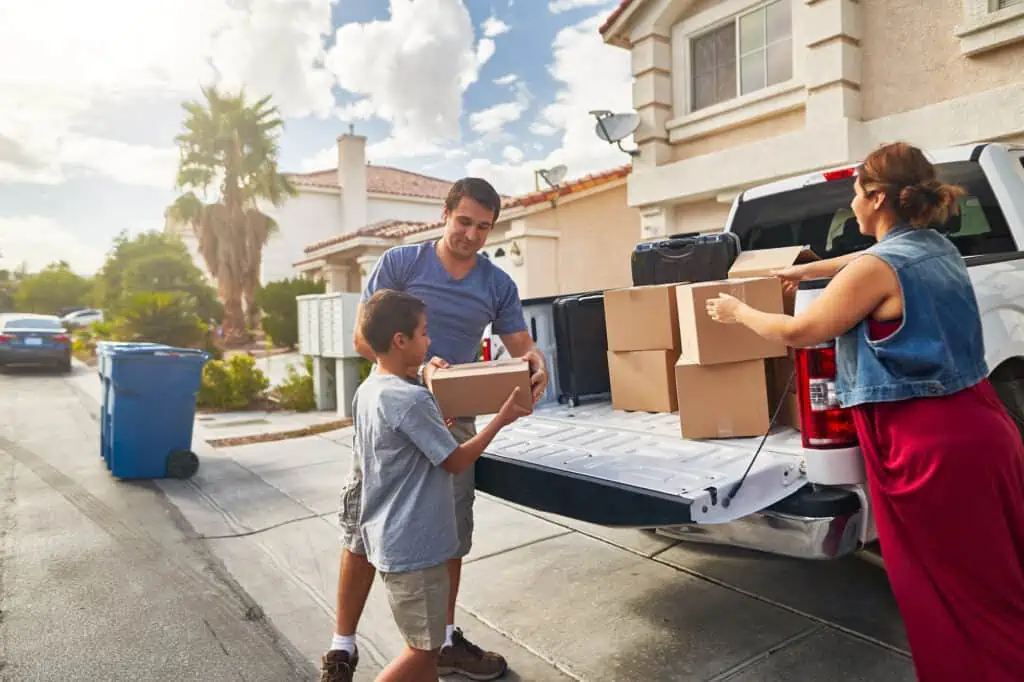What’s the Cheapest Way To Move? A Guide for Thrifty Moving
Posted in: Money Saving, Moving AdviceMoving is a common part of life, whether you’re seeking new opportunities, upsizing, downsizing, or just looking for a change. With the rise of remote work, there’s even more flexibility with where to live. Recent data indicates that people are still moving, so the demand for moving services keeps costs relatively high.
Fortunately, moving doesn’t have to break the bank. By planning carefully, starting early, and following the tips outlined below, you can save hundreds — if not thousands — while making your move as smooth and budget-friendly as possible.
A Guide to Getting the Cheapest Move Possible
Don’t know where to start? We’ve compiled a lot of info on getting the most out of your move on a budget. Here’s our expert guide to moving on a budget.
Step One: Declutter Your Stuff
Regardless of what else you may have heard, the two biggest factors that influence moving costs are:
- How you move: Whether you handle everything yourself, hire labor-only movers, or go full-service, every option comes with a cost
- The size of your move: The less you have, the less you pay. That’s why decluttering before your move is one of the best ways to cut costs
For example, a short-distance move costs between $900 and $2,500. Compare that to a long-distance move, which can cost up to $5,000 in transportation and moving expenses.
So, if you have a large apartment and sell or donate about a room’s worth of stuff, then you’re paying significantly less to move what’s left. As a bonus, you get a fresh start when decorating your new space.
To make your decluttering more practical and budget-friendly, try the following methods:
- One-year rule: If you haven’t used an item in a year, let it go
- The KonMari Method: Keep only the items that bring you joy. This approach encourages you to hold onto possessions that add value to your life
- Four-box method: Sort items into four categories — keep, donate, sell, and trash
Ready to move? Use HireAHelper’s cost comparison tool to find the best movers for your local or long-distance move.
Step Two: Avoid Buying Packing and Moving Supplies
One pack of tape is a negligible expense, but all of your packing and moving materials can add up (over $700 for a 4+ bedroom moving kit).
One way around this is to stash plastic bags, packing materials, and boxes in the months before your move. However, not everyone has this kind of foresight, much less the space in their house.
A week or two before your move, you can start seeking out free moving boxes. Places like your local grocer, liquor stores, furniture stores, and hotels often have boxes you can take, and they don’t tend to run out of them quickly like superstores. You can also check Facebook Marketplace, where people sometimes sell or even give away their used boxes.
Looking for a sustainable option? Utilize your own blankets, sheets, clothes, and towels as packing materials in addition to newspapers and magazines. You can also rent packing materials (like plastic boxes) and return them when you’re done.
Step Three: Pick the Right Time to Move
Timing is everything, as they say, and that’s especially true for moving. For one thing, you should avoid peak moving season (May through September) if you want to save cash and eliminate stress. But even the day of the week and time of day can affect your moving price tag.
For instance, it’s cheaper to move in the middle of the month, since leases typically start and end on the first. But moving on a Monday as opposed to a Saturday can also be cheaper when you’re renting a moving truck. As we found out, a U-Haul quote for Wednesday was $1.09/mile, but on Saturday, it jumped to $1.39 per mile!
“…if you’re moving between states and need to stay somewhere overnight to break up the drive, the price of hotels and fuel costs might cancel out what you were trying to save by going DIY”
If you’re paying for a rental truck or movers by the hour, then you’ll want to avoid rush hour — getting caught in traffic can send your prices through the roof. This happened to a friend of mine when she was moved across town in NYC, taking her $400 quote up to $750. The moral of the story? Booking your move earlier in the day to avoid traffic can help you save when hiring movers.
Step Four: Decide if DIY Is Best for You
Believe it or not, DIY might not be the cheapest option for you. In general, doing the entire move yourself does cost less (DIY moves average about $660, while a full-service move can cost up to $2,568), but depending on how you go about it, there can be a lot of hidden costs.
Your biggest expense is probably going to be your own time. You have to plan, take time off from work or school, get childcare if needed, and spend days doing really tiring work. Not to mention, if you’re moving between states and need to stay somewhere overnight to break up the drive, the price of hotels and fuel costs might cancel out what you were trying to save by going DIY.
If you research hotels and the route beforehand (and are smart about your PTO), you can still save. But that’s still more time spent planning out your move.
DIY is best if you:
- Don’t have a lot of stuff, or it’s all pretty cheap and replaceable
- Can easily take time off work or school
- Plan out driving routes, hotel stays, and other stops to find the cheapest options
Step Five: Decide if You Want Moving Help
Your other option is to hire moving help. You might already be thinking: How does hiring people help me save money? For one thing, it’s a lot cheaper to hire loading and unloading help when you’re driving than to hire a moving company to do it all for you. This is known as a “hybrid” move — a blend of DIY and a full-service move. Essentially, you handle the driving or arranging a container (like PODS) but pay for help to load and unload your stuff.
“If your vehicle can tow, renting a trailer may be more economical than a moving truck.”
Paying for moving help not only spares your back but can help you save on your truck or trailer rental. By using their expert packing skills, movers can help you fit more stuff into the space than you could on your own, all while securing your items so nothing gets damaged or breaks during the drive. It may be well worth dishing out an extra couple hundred to hire help if you can rent a smaller moving truck and protect your possessions.
Hiring moving help is best if you:
- Have a large home with a lot of heavy or fragile furniture
- Worry about being able to arrange childcare or PTO
- Can’t lift or carry heavy furniture easily
- Have several flights of stairs or tight corners to maneuver
Make sure any company you hire movers from is fully licensed and insured before committing. You should also look for honest reviews from past customers to get a sense of what the company is like. Avoid getting overly thrifty; good help is invaluable when you’re in the middle of a big move, and bad help can turn an already stressful experience into a nightmare — if not turn out to be an outright scam.
Step Six: Consider Portable Moving Containers
Portable moving containers serve as a flexible and cost-effective solution for those seeking a middle ground between a full-service move and a complete DIY approach. These containers are delivered to your location, allowing you to pack at your own pace. Once packed, the company transports the container to your new destination or a storage facility.
Benefits of using portable moving containers include:
- Flexibility and convenience: You can pack and unpack on your schedule without the pressure of tight deadlines.
- Cost-effectiveness: Using containers tends to be more affordable than hiring full-service movers, especially for long-distance relocations.
- Security: Containers are typically weatherproof and lockable, keeping your belongings safe and sound during transit.
- Storage options: If your new residence isn’t ready, the container can be stored at a secure facility until you’re prepared to move in.
Another advantage of moving containers is that they’re helpful in some specific yet quite common scenarios. If you’re situation is one of the following, you could really benefit from using a moving container:
- Staged moves: If there’s a gap between moving out of your old home and into your new one, containers provide a seamless storage solution.
- Home renovations: Be sure to store furniture and belongings safely during home improvement projects.
- Downsizing: When moving to a smaller space, containers can help you manage excess items until you decide what to keep, sell, or donate.
Step Seven: Look for Other Ways to Save on Your Move
Beyond the primary moving methods, consider these additional strategies to save money when moving:
- Use your car: Maximize space in your car by transporting smaller items yourself, reducing the load for movers.
- Rent a trailer: If your vehicle can tow, renting a trailer may be more economical than a moving truck.
- Get help from friends: Recruit friends or family to assist with packing and loading, offering meals or small incentives as a thank-you.
- Gather household items for packing: Use towels, blankets, and clothing as padding for fragile items, minimizing the need to purchase packing materials.
- Meal planning: In the weeks leading up to your move, plan meals that use perishable food items, reducing the amount you need to transport.
Step Eight: Make Some Extra Cash to Offset Moving Costs
Beyond cutting costs, you can make extra cash to help pay for your move. Selling items you no longer need can significantly offset your expenses. Here are some ways you can turn your clutter into cash.
Host a garage sale
With the advent of the internet, garage sales might seem a little outdated to some, but they’re still a great way to get rid of unwanted items while earning some cash. Follow these steps to have a successful garage sale:
- Pick a good date: Weekends, particularly Saturdays from 8 am to 1 pm, usually get the best traffic.
- Advertise effectively: Post in local forums and place clear signs around your home.
- Price strategically: Clearly price all items with removable stickers. Bundle smaller items together to encourage more purchases.
- Set up neatly: Organize items by category (clothing, furniture, toys) to make browsing easy and appealing.
- Have change on hand: Prepare plenty of small bills and coins.
Sell online based on item type
Did you know that different platforms work best for different items? By tailoring where you sell what online, you have a better chance of the right person seeing your listing and getting a successful sale. See which sites you should be selling your stuff on:
- eBay: Ideal for collectibles, electronics, and unique vintage items. Use clear, bright photos, detailed descriptions, and respond promptly to potential buyers.
- Depop: Perfect for stylish or vintage clothing, shoes, and accessories. Good photos and detailed item descriptions can make your listings stand out.
- Craigslist or Facebook Marketplace: Best for selling furniture and larger items locally. Provide clear dimensions and offer safe public meeting places for pickups.
There are definitely more than this list out there, too! When you’re considering which sites to use, take a quick look around other listings to get an idea of what kinds of items sell best, and tailor your own to match.
Sell items in person
If you’re not keen on a garage sale but still want to sell your items IRL rather than online, you’ve still got options. You can make money by dropping off certain items in person:
- Consider consignment shops: These stores sell your items and give you a percentage of the sale. It’s a great option for high-quality furniture and clothing. Keep seasonal trends in mind and negotiate the terms for higher payouts.
- Recycle electronics for cash: Instead of throwing out old electronics, take advantage of trade-in programs offered by Best Buy, Apple, or Amazon. You can trade in old devices like smartphones, tablets, or laptops for gift cards or cash.
- Sell scrap metal and appliances: Local recycling centers will buy scrap metal and appliances like old washers or refrigerators. Check local metal recycling businesses to compare prices and ensure you’re getting the best rate.
There also might be antique stores or similar shops in your area that will buy furniture or clothing from you. It doesn’t hurt to do a quick search or ask around on a local forum to see if there are places in your neighborhood that would be happy to buy.
Sell your car if moving long-distance
Driving your car cross-country is impractical, and shipping it can be prohibitively expensive in some cases. Consider selling your car to help finance your move (or a new ride at your new place). You can follow these steps to help you prepare and get the best price:
- Prepare your car: Thoroughly clean it, and gather all maintenance records and the title.
- Determine your car’s value: Check websites like Kelley Blue Book for accurate pricing.
- List your vehicle online: Platforms such as Autotrader and Cars.com can help you find serious buyers.
- Write a strong listing: Include multiple clear photos and an honest, detailed description.
- Arrange safe test drives: Meet potential buyers in public, secure locations.
- Close the sale: Carefully complete the paperwork, ensuring payment is confirmed securely before handing over the keys.
Additional ideas
Here are some additional ideas to make some extra cash:
- If your new home has a spare room, consider renting it through Neighbor.com. This platform connects you with neighbors looking for storage, creating passive income with minimal effort.
- Sell textbooks or books on BookScouter or Amazon.
- List unused gift cards on websites like CardCash to get immediate cash.
- Use ThredUp to sell gently used clothing online without much effort.
Making Your Move Affordable and Stress-Free
Moving doesn’t have to be expensive or overwhelming. Decluttering, using free packing materials, choosing the right time to move, and considering DIY options or moving help can significantly reduce costs. Exploring portable moving containers and finding ways to earn extra cash during the process can further ease the financial burden. With careful planning and smart choices, you can transition to your new home without unnecessary stress or expenses.


